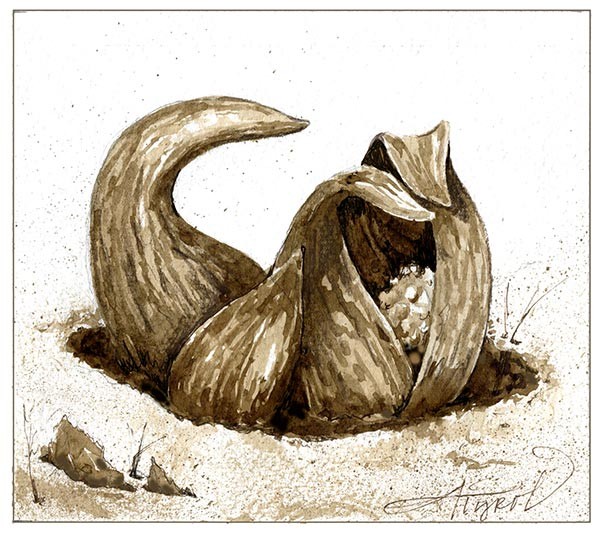
Every year, in mid-March, my family leaves Vermont and heads to Massachusetts’ Pioneer Valley to get a jump on experiencing spring. Red-winged blackbirds are calling, chipmunks are foraging and flocks of robins abound. Bending down to smell the first subtle scents of crocuses and daffodils, we give thanks that winter is over. Sometimes, we also take a whiff of skunk cabbage flowers, just for the olfactory shock value.
Skunk cabbage grows throughout the Northeast and Midwest, ranging from North Carolina well up into the northernmost reaches of Quebec. The flower emerges through the snow and ice of March in the understory of wooded swamps, along riverbanks, lakeshores, and in other habitats with rich wet soils. First growth is an exotic, crimson-hued, three to six inch tall cowl –called a spathe - that surrounds and protects a spherical cluster of flowers. Each flower measures ¾-inch across and consists of 50 to 100 tightly packed florets.
Seeing a skunk cabbage poke through the snow, it‘s easy to assume that its dark color has absorbed the sun’s heat and melted a ring around itself, much like bark does around a tree. But the plant’s behavior is as exotic as its appearance. During the two week period when the male flowers are pollinating and female flowers are receptive to being pollinated, the sex organs of the flower generate their own heat.
Biologist Roger Knutson discovered that skunk cabbage flowers can maintain a temperature that’s significantly higher than the air surrounding it. A field study conducted in Ontario during the month of March found that when the outside temperature is just 37 degrees, the air inside the spathe is maintained at a balmy 61 degrees. If the air temperature drops below 37 degrees, flowers can’t produce enough heat to keep up, but the flowers don’t freeze until exposed to 14 degrees or below.
Plants respire just like animals do, and skunk cabbage produces energy from starch that’s stored in the roots. During their pollination phase, skunk cabbage flowers consume as much oxygen, by mass, as a shrew or hummingbird. As air temperature falls, the skunk cabbage responds by increasing its metabolism and heat production.
This self-generated warmth promotes early pollination, protects flowers from freezing and frost, mobilizes the flower’s fetid scent, and provides a haven for early-season insects. Pollen-gathering honeybees, in particular, are attracted to skunk cabbage flowers that are the most odoriferous. Some conjecture that the flowers may also mimic the heat generated by a rotting corpse as an additional lure for carrion-eaters.
Our native skunk cabbage is among just a handful of related heat-generating species of plants in existence. For example, the cut-leaf philodendron (Philodendron selloum) of the southern Brazilian rainforest burns fat to maintain a temperature of 114 degrees during its two day flowering period. Another heat-producing relative is the European arum lily (Arum maculatum). In all of these plants, heat production is timed to coincide with blooming and pollination.
So when you see a skunk cabbage melting through the snow, you can be sure it’s pollinating. Bend down and gently feel the heat of the flower. There, at ground level where the wind is fairly calm, a gentle circulation pattern flows as the lighter, warmer air rises out the top of the spathe and the colder, heavier air enters below.
You may also see some of the many species that take advantage of this plant’s micro-environment. In addition to pollen-gathering honeybees and carrion-eating insects such as flies, a number of other invertebrates are drawn to skunk cabbage flowers. Springtails, beetles, sow bugs, true bugs, and the larvae of butterflies and moths have been discovered in these outposts of nourishment. And where insects visit, spiders follow. Ironically, insects lured in by the smell of death, may lose their lives in the pursuit.


Discussion *